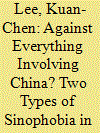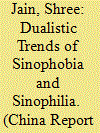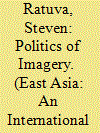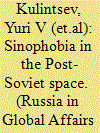|
|
|
Sort Order |
|
|
|
Items / Page
|
|
|
|
|
|
|
| Srl | Item |
| 1 |
ID:
161618


|
|
|
|
|
| Summary/Abstract |
This paper develops a two-dimensional concept of Sinophobia (恐中) to study Taiwanese attitudes toward mainland China as well as their sources and political consequences. Taiwanese skepticism toward China has grown in recent years, concomitant with increasing cross-Strait interactions and exchanges. This has been widely characterized as a “Sinophobia syndrome.” To investigate this phenomenon, we divide Sinophobia into two types—“group-difference-driven” and “risk-driven”—and investigate whether the two types exert different effects on individual preferences regarding policies involving China. Multivariate analyses show that a model that distinguishes between the two types of Sinophobia fits the data very well and that the risk-driven attitude influences decisions on issues related to China more strongly than does the group-difference-driven attitude. This finding suggests that although perceptions of group difference may prompt fears of China, it is not a powerful determinant of policy preferences. Additional analyses reveal that the risk-driven attitude also influences other policy-relevant attitudes and behavior, including voting in the 2012 presidential election.
|
|
|
|
|
|
|
|
|
|
|
|
|
|
|
|
| 2 |
ID:
189229


|
|
|
|
|
| Summary/Abstract |
The People’s Republic of China has invited both fascination and fear, admiration and contempt in the last few years. Various public opinion surveys’ data findings reveal a nuanced and conflicted phenomenon of ‘Sinophobia’ and ‘Sinophillia’ across the world nations. One view of China is that of an ‘autocratic,’ ‘anti-democratic’ regime provoking anxiety and suspicion reflected in a trending wave of anti-China sentiments evolving into ‘Sinophobia,’ with its prevalence and intensity highlighted in increasing cases of racism and violence towards immigrant Chinese after the novel coronavirus outbreak. The growing intensity of Sinophobia is noticed in countries witnessing a barging influx of Chinese investment with Chinese land grabs and the loss of native jobs. However, another view is of a nation that inspires vast admiration for its economic ascent and traditional culture. Today, China has an increasing appeal and attraction not just for its economic engagement but also for its culture, language and tourism.
|
|
|
|
|
|
|
|
|
|
|
|
|
|
|
|
| 3 |
ID:
192987


|
|
|
|
|
| Summary/Abstract |
This article examines perceptions of China and contributes to the ongoing academic debate on Sinophobia in Central Asia. However, unlike existing studies, it specifically focuses on perceptions of those, who have first-hand China experience – Kazakh students/graduates of Chinese universities. Based on in-depth interviews with them, the article argues that those with first-hand China experience tend to reject the China threat theory, found to be widespread among the general population. Instead, China-educated Kazakh youth perceive China mostly as an economic opportunity for their own country. Yet, this does not necessarily make them Sinophiles in the sense that they still express certain concerns related to their country’s potential over-dependence on China. But more interestingly, they see China as the “civilizational other.” This perceived civilisational abyss even among the more-informed segments of the population appears to be one of the main causes of the alienation of China and the Chinese in Kazakhstan.
|
|
|
|
|
|
|
|
|
|
|
|
|
|
|
|
| 4 |
ID:
197258


|
|
|
|
|
| Summary/Abstract |
Scholars have often assumed that a decolonial agenda would empower emancipatory and anti-racist movements. Nevertheless, there is also increasing recognition by scholars that the language of decolonization has been co-opted to support right-wing ideologies and majoritarian agendas, most prominently in India and Turkey. Similarly, in Malaysia, right-wing actors use decolonial rhetoric to criticize ethnic, religious, gender, and sexual minorities and silence their demands for equal rights. These actors have justified their intolerance by labelling any perceived threats to heteronormative Malay Muslim identity as examples of “Western imperialism” or “Chinese colonialism.” This article illustrates how decolonial vocabulary has been transformed into Sinophobia and homophobia by a right-wing Islamist group in Malaysia. It shows how revisionist nativist historiography, racism, and conspiracy theories can be integrated with moralistic calls for decolonization. Tracing developments over the past decade, the paper demonstrates how persistent dissemination, intellectual laundering, and innovative marketing strategies have helped mainstream a nativist Islamist decolonial agenda in Malaysia.
|
|
|
|
|
|
|
|
|
|
|
|
|
|
|
|
| 5 |
ID:
186112


|
|
|
|
|
| Summary/Abstract |
The weaponization of racialized imagery has been a common feature of geopolitical contestation in contemporary history. The paper critically examines the historical genesis of Sinophobic narratives, which have been common features of the big power geopolitical contestation in the Pacific. The globalization of capitalism in the nineteenth century and the West’s attempts to penetrate the Chinese market and exploitation of its resources led to tension, skirmishes and wars. The myth of racial European superiority and corresponding inferiority of the Chinese was weaponized as an ideological justification for colonial domination, exploitation of cheap labour and appropriation of China’s resources and wealth. In recent years, the Sinophobic paranoia has been exacerbated by China’s Belt and Road initiative, a strategy at global economic and technological supremacy to counter the West’s dominance. This competition for global hegemony is played out in various parts of the world and the Pacific included. The paper critically discusses various historical factors associated with Sinophobia in the context of the USA, France and Australia and how these have influenced these countries’ contemporary approaches to Chinese expansionism.
|
|
|
|
|
|
|
|
|
|
|
|
|
|
|
|
| 6 |
ID:
174878


|
|
|
|
|
| Summary/Abstract |
A team of authors representing various countries of the Eurasian Economic Union analyzed anti-Chinese protests that took place in the 2010s in Russia, Kazakhstan, and Kyrgyzstan—EAEU countries that are China’s partners in implementing the Belt and Road Initiative. Based on empirical data concerning anti-Chinese protests, the paper examines the reaction of the authorities, public and expert discussion on the causes and further development of the situation, and offers some recommendations to the authorities of the countries in question on how to build constructive cooperation with China. An analysis of the causes and mechanisms of anti-Chinese protests in various countries shows that, despite some specific features, these countries face similar problems. The current situation can only partly be explained by the natural reaction of society to the continuing economic expansion of China. The basic reason for the protests was the lack of public trust in statements made by the authorities and the failure of existing government-society feedback mechanisms. As a result, society did not understand and rejected certain cooperation projects with China even though they were beneficial for the socioeconomic development of the countries and regions being considered.
|
|
|
|
|
|
|
|
|
|
|
|
|
|
|
|
|
|
|
|
|